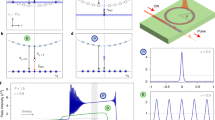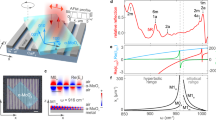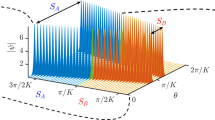Abstract
High-quality crystals without inversion symmetry are the conventional platform to achieve optical frequency conversion via three-wave mixing. In bulk crystals, efficient wave mixing relies on phase-matching configurations, while at the micro- and nanoscale it requires resonant mechanisms that enhance the nonlinear light–matter interaction. These strategies commonly result in wavelength-specific performances and narrowband applications. Disordered photonic materials, made up of a random assembly of optical nonlinear crystals, enable a broadband tunability in the random quasi-phase-matching regime and do not require high-quality materials. Here, we combine resonances and disorder by implementing random quasi-phase-matching in Mie resonant spheres of a few micrometres realized by the bottom-up assembly of barium titanate nanocrystals. The measured second-harmonic generation reveals a combination of broadband and resonant wave mixing, in which Mie resonances drive and enhance the second-harmonic generation, while the disorder keeps the phase-matching conditions relaxed. Our nanocrystal assemblies provide new opportunities for tailored phase matching at the microscale, beyond the coherence length of the bulk crystal. They can be adapted to achieve frequency conversion from the near-ultraviolet to the infrared ranges, are low cost and can cover large surface areas.
This is a preview of subscription content, access via your institution
Access options
Access Nature and 54 other Nature Portfolio journals
Get Nature+, our best-value online-access subscription
$29.99 / 30 days
cancel any time
Subscribe to this journal
Receive 12 print issues and online access
$209.00 per year
only $17.42 per issue
Buy this article
- Purchase on Springer Link
- Instant access to full article PDF
Prices may be subject to local taxes which are calculated during checkout






Similar content being viewed by others
Data availability
The data that support the plots within this paper and other findings of this study are available from the corresponding author upon reasonable request.
Code availability
The codes that support the findings of this study are available from the corresponding author upon reasonable request.
References
Boyd, R. W. Nonlinear Optics (Elsevier, 2008).
Kwiat, P. G. et al. New high-intensity source of polarization-entangled photon pairs. Phys. Rev. Lett. 75, 4337–4341 (1995).
Shen, Y. R. A few selected applications of surface nonlinear optical spectroscopy. Proc. Natl Acad. Sci. USA 93, 12104–12111 (1996).
Werner, C. S., Buse, K. & Breunig, I. Continuous-wave whispering-gallery optical parametric oscillator for high-resolution spectroscopy. Opt. Lett. 40, 772–775 (2015).
Campagnola, P. J. & Loew, L. M. Second-harmonic imaging microscopy for visualizing biomolecular arrays in cells, tissues and organisms. Nat. Biotechnol. 21, 1356–1360 (2003).
Trebino, R. Frequency-Resolved Optical Gating: The Measurement of Ultrashort Laser Pulses (Springer Science & Business Media, 2012).
Caspani, L. et al. Integrated sources of photon quantum states based on nonlinear optics. Light Sci. Appl. 6, e17100 (2017).
Günter, P. Nonlinear Optical Effects and Materials Vol. 72 (Springer, 2012).
Fejer, M. M., Magel, G., Jundt, D. H. & Byer, R. L. Quasi-phase-matched second harmonic generation: tuning and tolerances. IEEE J. Quant. Electron. 28, 2631–2654 (1992).
Moutzouris, K. et al. Second-harmonic generation through optimized modal phase matching in semiconductor waveguides. Appl. Phys. Lett. 83, 620–622 (2003).
Lin, G., Fürst, J. U., Strekalov, D. V. & Yu, N. Wide-range cyclic phase matching and second harmonic generation in whispering gallery resonators. Appl. Phys. Lett. 103, 181107 (2013).
Rivoire, K., Buckley, S. & Vučković, J. Multiply resonant photonic crystal nanocavities for nonlinear frequency conversion. Opt. Express 19, 22198–22207 (2011).
Lin, Z., Liang, X., Lončar, M., Johnson, S. G. & Rodriguez, A. W. Cavity-enhanced second-harmonic generation via nonlinear-overlap optimization. Optica 3, 233–238 (2016).
Suchowski, H. et al. Phase mismatch–free nonlinear propagation in optical zero-index materials. Science 342, 1223–1226 (2013).
Pu, Y., Grange, R., Hsieh, C.-L. & Psaltis, D. Nonlinear optical properties of core-shell nanocavities for enhanced second-harmonic generation. Phys. Rev. Lett. 104, 207402 (2010).
Suchowski, H., Bruner, B. D., Arie, A. & Silberberg, Y. Broadband nonlinear frequency conversion. Opt. Photon. News 21, 36–41 (2010).
Baudrier-Raybaut, M., Haidar, R., Kupecek, P., Lemasson, P. & Rosencher, E. Random quasi-phase-matching in bulk polycrystalline isotropic nonlinear materials. Nature 432, 374–376 (2004).
Skipetrov, S. E. Nonlinear optics: disorder is the new order. Nature 432, 285–286 (2004).
Vidal, X. & Martorell, J. Generation of light in media with a random distribution of nonlinear domains. Phys. Rev. Lett. 97, 013902 (2006).
Bravo-Abad, J., Vidal, X., Juárez, J. L. D. & Martorell, J. Optical second-harmonic scattering from a non-diffusive random distribution of nonlinear domains. Opt. Express 18, 14202–14211 (2010).
Ru, Q. et al. Optical parametric oscillation in a random polycrystalline medium. Optica 4, 617–618 (2017).
Fischer, R., Saltiel, S., Neshev, D., Krolikowski, W. & Kivshar, Y. S. Broadband femtosecond frequency doubling in random media. Appl. Phys. Lett. 89, 191105 (2006).
Molina, P., de la O Ramírez, M. & Bausá, L. E. Strontium barium niobate as a multifunctional two-dimensional nonlinear ‘photonic glass’. Adv. Funct. Mater. 18, 709–715 (2008).
Ricciardi, I. et al. Frequency comb generation in quadratic nonlinear media. Phys. Rev. A 91, 063839 (2015).
Kuznetsov, A. I., Miroshnichenko, A. E., Brongersma, M. L., Kivshar, Y. S. & Luk’yanchuk, B. Optically resonant dielectric nanostructures. Science 354, aag2472 (2016).
Kim, E. et al. Second-harmonic generation of single BaTiO3 nanoparticles down to 22 nm diameter. ACS Nano 7, 5343–5349 (2013).
Timpu, F., Sergeyev, A., Hendricks, N. R. & Grange, R. Second-harmonic enhancement with Mie resonances in perovskite nanoparticles. ACS Photonics 4, 76–84 (2016).
de Boer, J. F., Lagendijk, A., Sprik, R. & Feng, S. Transmission and reflection correlations of second harmonic waves in nonlinear random media. Phys. Rev. Lett. 71, 3947–3950 (1993).
Faez, S., Johnson, P., Mazurenko, D. & Lagendijk, A. Experimental observation of second-harmonic generation and diffusion inside random media. J. Opt. Soc. Am. B 26, 235–243 (2009).
Makeev, E. & Skipetrov, S. Second harmonic generation in suspensions of spherical particles. Opt. Commun. 224, 139–147 (2003).
Kim, S.-H. et al. Microspheres with tunable refractive index by controlled assembly of nanoparticles. Adv. Mater. 20, 3268–3273 (2008).
Vogel, N. et al. Color from hierarchy: diverse optical properties of micron-sized spherical colloidal assemblies. Proc. Natl Acad. Sci. USA 112, 10845–10850 (2015).
Vogler-Neuling, V. V. et al. Solution-processed barium titanate nonlinear woodpile photonic structures with large surface areas. Physica Stat. Solidi b 257, 1900755 (2020).
Yang, H., Moullan, N., Auwerx, J. & Gijs, M. A. Super-resolution biological microscopy using virtual imaging by a microsphere nanoscope. Small 10, 1712–1718 (2014).
Checcucci, S. et al. Titania-based spherical Mie resonators elaborated by high-throughput aerosol spray: single object investigation. Adv. Funct. Mater. 28, 1801958 (2018).
Lalanne, P., Yan, W., Vynck, K., Sauvan, C. & Hugonin, J.-P. Light interaction with photonic and plasmonic resonances. Laser Photon. Rev. 12, 1700113 (2018).
Chen, Z., Taflove, A. & Backman, V. Photonic nanojet enhancement of backscattering of light by nanoparticles: a potential novel visible-light ultramicroscopy technique. Opt. Express 12, 1214–1220 (2004).
Geints, Y. E., Zemlyanov, A. A. & Panina, E. K. Photonic jets from resonantly excited transparent dielectric microspheres. J. Opt. Soc. Am. B 29, 758–762 (2012).
Molina, P. et al. Nonlinear prism based on the natural ferroelectric domain structure in calcium barium niobate. Appl. Phys. Lett. 94, 071111 (2009).
Goodman, J. W. Some fundamental properties of speckle. J. Opt. Soc. Am. 66, 1145–1150 (1976).
Zhong, J.-H. et al. Nonlinear plasmon-exciton coupling enhances sum-frequency generation from a hybrid metal/semiconductor nanostructure. Nat. Commun. 11, 1464 (2020).
Setzler, S. et al. Periodically poled barium titanate as a new nonlinear optical material. In Advanced Solid State Lasers Paper MD1 (Optical Society of America, 1999).
Wiersma, D. S. Disordered photonics. Nat. Photon. 7, 188–196 (2013).
Rotter, S. & Gigan, S. Light fields in complex media: mesoscopic scattering meets wave control. Rev. Mod. Phys. 89, 015005 (2017).
Florescu, M., Torquato, S. & Steinhardt, P. J. Designer disordered materials with large, complete photonic band gaps. Proc. Natl Acad. Sci. USA 106, 20658–20663 (2009).
Frostig, H. et al. Focusing light by wavefront shaping through disorder and nonlinearity. Optica 4, 1073–1079 (2017).
Qiao, Y., Peng, Y., Zheng, Y., Ye, F. & Chen, X. Second-harmonic focusing by a nonlinear turbid medium via feedback-based wavefront shaping. Opt. Lett. 42, 1895–1898 (2017).
Barh, A., Rodrigo, P. J., Meng, L., Pedersen, C. & Tidemand-Lichtenberg, P. Parametric upconversion imaging and its applications. Adv. Opt. Photon. 11, 952–1019 (2019).
Acknowledgements
We acknowledge discussions with M. Lehner, C. Renaut, V. Vogler-Neuling and L. Pattelli. We acknowledge support from the FIRST—Center for Micro and Nanoscience of ETHZ and from the Scientific Center of Optical and Electron Microscopy (ScopeM) of ETHZ. The project has received funding from the European Union’s Horizon 2020 research and innovation programme under the Marie Skłodowska-Curie grant agreement no. 800487 (SECOONDO) and from the European Research Council under the grant agreement no. 714837 (Chi2-nano-oxides). We thank the Swiss National Science Foundation (SNF) grant 150609.
Author information
Authors and Affiliations
Contributions
R.S. and R.G. conceived the work. R.S., M.Z. and L.I. developed the assembly method. R.S., A.M., F.K. and M.R.E. realized the structures, performed the FIB cuts and the SEM characterization. A.M., J.S.M. and F.T. performed the simulations. R.S., A.M. and J.S.M. developed the theory. R.S., A.M., J.S.M. and R.G. analysed the data. R.S. wrote the first draft of the manuscript. All authors discussed the results and contributed to the writing of the manuscript.
Corresponding author
Ethics declarations
Competing interests
The authors declare no competing interests.
Additional information
Publisher’s note Springer Nature remains neutral with regard to jurisdictional claims in published maps and institutional affiliations.
Supplementary information
Supplementary Information
Supplementary Discussion, Figs. 1–15 and Table 1.
Rights and permissions
About this article
Cite this article
Savo, R., Morandi, A., Müller, J.S. et al. Broadband Mie driven random quasi-phase-matching. Nat. Photonics 14, 740–747 (2020). https://doi.org/10.1038/s41566-020-00701-x
Received:
Accepted:
Published:
Issue Date:
DOI: https://doi.org/10.1038/s41566-020-00701-x
This article is cited by
-
Near-field enhancement of optical second harmonic generation in hybrid gold–lithium niobate nanostructures
Light: Science & Applications (2023)
-
Crystallization of binary nanocrystal superlattices and the relevance of short-range attraction
Nature Synthesis (2023)
-
Raman scattering enhancement of dielectric microspheres on silicon nitride film
Scientific Reports (2022)
-
Multilevel polarization switching in ferroelectric thin films
Nature Communications (2022)
-
Subwavelength hybrid plasmonic structures for nonlinear nanophotonics
Light: Science & Applications (2021)



